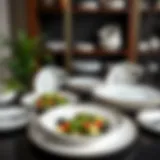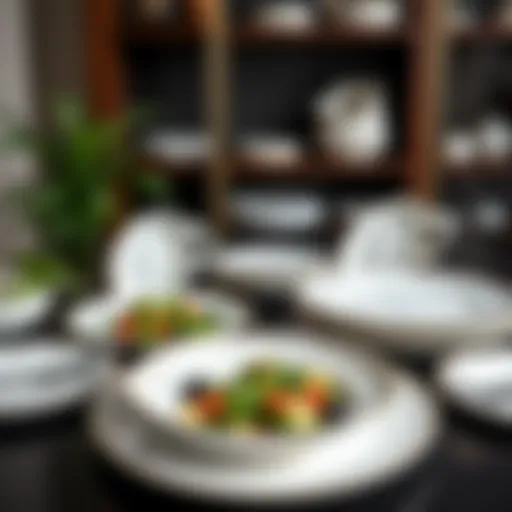Enhance Your Space with Rustic Shelves in Design
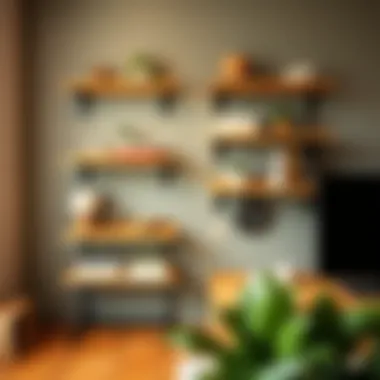

Intro
Rustic shelves are more than just functional elements—they're the heartbeat of contemporary design that whispers tales of nature and nostalgia. As we traverse the landscape of wall design, these shelves emerge as cornerstones, blending aesthetics with utility. This article aims to peel back the layers of rustic shelving, illustrating how they can elevate the visual appeal of any space while serving practical needs.
Their charm lies not only in their raw beauty but also in the myriad ways they can transform walls into captivating stories. From the homey ambience of a farmhouse to the sleek lines of modern minimalism, rustic shelves adapt and thrive, begging to be integrated into diverse environments.
Through this exploration, we will delve into design inspiration that draws from trending furniture styles and carefully curated color palettes. Furthermore, practical advice will guide both homeowners and design professionals in maintaining the longevity and functionality of these captivating design elements. Let’s dive in and see what magic rustic shelves can bring to your walls.
Prologue to Rustic Shelves
Rustic shelves represent more than just a means of storage; they embody a way of breathing life and character into any space. When considering the design of a room, wall shelves serve as a framework that can elevate the overall ambiance and functionality. Choosing rustic designs can instill warmth and a sense of homeliness, attributes often sought after by homeowners and designers alike.
Definition and Characteristics
Rustic shelves are typically characterized by their raw, unfinished look. Often made from natural materials like reclaimed wood, these shelves celebrate imperfections—they invite the viewer to appreciate the beauty in their rugged textures and organic forms. This type of shelving may feature:
- Uneven edges and knots
- Varied wood tones and grain patterns
- Minimalist supports that emphasize the shelf itself
- Distressing that suggests age without compromising its sturdiness
Such elements contribute to the rustic aesthetic while ensuring the piece can still serve its practical purpose.
The Popularity of Rustic Aesthetics
The trend towards rustic design can be seen across various domains of home decor. This appeal stems primarily from a collective yearning to integrate nature into urban lifestyles. Few elements evoke nostalgia and comfort quite like wood, particularly when it has been repurposed.
The rustic aesthetic connects individuals to simpler times, a notion that resonates in a fast-paced world. Designers often find success in blending rustic shelves into contemporary styles, allowing for more creative expression within modern spaces.
As rustic shelves gain traction, they also foster sustainability by promoting the use of reclaimed materials. This trend not only appeals to eco-conscious homeowners but also speaks to a wider cultural movement that values craftsmanship and authenticity in design. In a small way, every rustic shelf tells a story, offering glimpses into the past while making room for the present.
"Using rustic shelves is not merely a design choice; it’s an invitation to reflect on the past while embracing the future."
Overall, the charm of rustic shelves lies in their ability to blend seamlessly into varying interior styles, making them an essential consideration for anyone looking to enhance their living space.
Materials Used in Rustic Shelving
When diving into the world of rustic shelves, one can't overlook the importance of materials used in their creation. The selection of materials not only influences the aesthetic appeal of the shelves but also affects their durability and functionality. Next, we'll explore several categories of materials that contribute to the charm of rustic shelving, emphasizing their distinct characteristics and why they stand out in the realm of wall design.
Natural Wood Varieties
Reclaimed Wood
Reclaimed wood has become a showcase of sustainability and antique charm in rustic design. This variety is sourced from old buildings, barns, or ships, embracing the scars of its history. The key characteristic of reclaimed wood is its unique texture and rich patina, which can’t be replicated in new wood. This makes it an awe-inspiring choice for shelves that tell a story of their past. However, one must consider that reclaimed boards might have imperfections, like nail holes or warps, which can either add character or pose challenges in uniformity.
- Advantages: Ecological benefits, historical aesthetics, and each piece being one-of-a-kind.
- Disadvantages: Variations in quality and potential for pests if not properly treated.
Hardwood Options
Hardwood options, such as oak, cherry, and maple, are revered for their strength and longevity. The density of these woods makes them a practical choice for shelving that bears weight. A highlight of hardwood is its smooth texture and ability to hold finishes well. This means you can customize the look with stains and paints, offering flexibility in design. However, hardwood can be pricier than softwoods, which might be a consideration for those on a budget.
- Advantages: Sturdy and durable, elegant appearance, and variety in grain patterns.
- Disadvantages: Higher cost and can be harder to work with due to density.
Softwood Choices
Softwood varieties, like pine and cedar, offer another path along the rustic shelving journey. These woods often come from faster-growing trees, which helps in keeping costs down. The key characteristic of softwoods is their lighter weight and easier workability, making them a favorite among DIY enthusiasts. They can be stained or left natural for a more casual, rustic look. However, they may require more frequent maintenance since they are generally less resistant to wear and tear compared to hardwoods.
- Advantages: Affordable, readily available, and lightweight.
- Disadvantages: Susceptible to scratches and dents, requiring more care over time.
Metal Elements in Rustic Shelving
Iron Brackets
Iron brackets offer an industrial touch that complements rustic designs beautifully. Their raw finish and robustness not only make them functional but stylish as well. A draw of using iron brackets is their ability to support substantial weight, making them suitable for heavier wood shelves. They often feature a hand-forged appearance, which adds character to the shelves. One aspect to consider is the potential for rust if not properly finished, especially in humid environments.
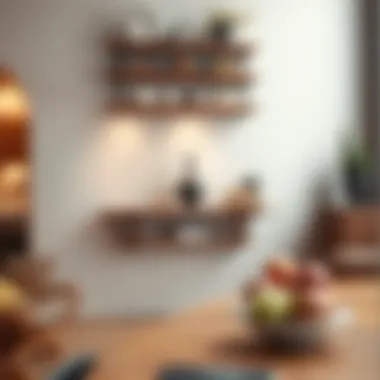

- Advantages: Extremely strong and durable, adds a vintage vibe.
- Disadvantages: Can rust without proper treatment, and may be heavier than other materials.
Steel Accents
Steel accents in rustic shelving bring a modern, yet rugged aesthetic. These can be used in brackets, straps, or decorative elements, providing contrast against the natural warmth of wood. The key feature of steel is versatility; it can be shaped and finished in numerous ways to fit your style. Additionally, steel is incredibly resilient, making it a long-lasting choice. However, while it provides a sleek look, some may find it too cold against the warm textures of wood.
- Advantages: Offers a sleek, modern touch, highly durable.
- Disadvantages: Might not suit everyone’s taste, can be less forgiving in rustic schemes.
Composite Materials
MDF with Wood Veneer
Using MDF (Medium Density Fiberboard) with a wood veneer finish can be an appealing option for those seeking a budget-friendly yet stylish solution. This composite material combines the stability of MDF, which resists warping, with the beauty of wood veneer. Its key characteristic is the smooth surface that paints and stains can easily adhere to, allowing for a customized appearance. While it offers a polished look, MDF cannot withstand moisture well, which may limit where these shelves can be placed.
- Advantages: Cost-effective, versatility in design, and easy to work with.
- Disadvantages: Not suitable for high-moisture areas and can lack the natural grain of real wood.
Plywood Options
Plywood, made of layers of wood veneer, brings strength and stability to rustic shelving without the weight of solid wood. Its unique feature is that it combines multiple wood types in its construction, which can add an unusual visual element dependent on the layup. Plywood is a strong material, making it capable of holding heavier items. However, the aesthetic appeal is not as strong as solid wood, sometimes requiring additional finishes to achieve that rustic look.
- Advantages: Durable, lighter than solid wood, and can be less expensive.
- Disadvantages: The look may not be as authentic as solid wood, potential for edge splitting.
Design Styles of Rustic Shelves
Exploring the design styles of rustic shelves is not merely an exercise in aesthetics; it unveils how these functional pieces of furniture can dramatically shift the atmosphere of a space. Each design style encapsulates a unique narrative, advances a specific mood, and showcases an array of craftsmanship that speaks to personal taste as well as practical application. Integrating rustic shelves into interior design can enhance warmth and character, bring balance to modern features, and facilitate fluidity between spaces.
The benefits of understanding different design styles extend to both homeowners looking to make their spaces inviting and professional designers aiming to create cohesive designs. As you read through, consider how each style may serve your purpose or influence your space in a way that creates harmony and style.
Traditional Farmhouse Style
The traditional farmhouse style is a hallmark of rustic design, harking back to simpler times where homes were constructed for utility as much as comfort. Characterized by carefully distressed wood, neutral color palettes, and often vintage accessories, farmhouse shelves are particularly adept at marrying form and function. Wood species such as oak, pine, and cedar frequently dominate this style, showcasing unique grain patterns and imperfections that add character.
Farmhouse shelves don’t just hold items; they tell stories. A stack of old books, jars of preserved fruits, or handmade pottery can create a vignette that echoes nostalgia and simplicity. Additionally, open shelving allows for easy access and visibility, encouraging organization while inviting creative displays. Furthermore, the ample space created by these shelves maximizes verticality in a room, drawing the eye upward and making ceilings feel higher, thus amplifying the airy, spacious feeling inherent to farmhouse aesthetics.
Industrial Rustic Fusion
The industrial rustic fusion draws from both the raw, unpolished feel of industrial design and the warmth of rustic elements. This style features a juxtaposition of materials: the roughness of reclaimed wood harmonized with colder metal accents like iron or steel. This aesthetic captures a modern yet cozy look that is both pleasing to (and easy on) the eyes.
When selecting pieces, think of dramatic metal brackets supporting rustic wooden planks. The combination evokes a narrative of transformation, as if once serving as a part of an old warehouse, now it elevates your living space. This hybrid style appeals to those who appreciate a modern edge but still yearn for tactile warmth. Integrating industrial rustic shelving into spaces like kitchens or living rooms can facilitate functional display areas and redefine how one perceives a 'working' space.
Modern Rustic Trends
Modern rustic trends twist traditional concepts of rustic design, steering towards clean lines and minimalist approaches while retaining the organic appeal of natural materials. Here, you'll often find smoother finishes, lighter wood stains, and simplified forms that blend seamlessly with contemporary décor.
Modern rustic shelving often incorporates open designs that emphasize airy layouts, creating a sophisticated feel without sacrificing warmth. When styled thoughtfully, modern rustic shelves can also be adorned with curated collections of art, plants, or decorative objects that instill personality and life into a room. This style resonates especially well with homeowners that seek tranquility yet want their spaces to feel polished and contemporary.
Cottage-Inspired Designs
Cottage-inspired designs embody a charming, cheerful style that harkens to a sense of escape and relaxation. Typically characterized by their quaint, slightly whimsical aesthetics, these shelves often use lighter woods, pastel colors, and soft rounded edges.
Cottage shelves thrive on personalization. They encourage you to display curated collections of vintage finds, cherished books, or even floral arrangements. This design style transforms rustic shelving into a canvas for individual expression, allowing you to reflect your personality and interests in a casual manner. Emphasizing comfort and familiarity, these designs are often perfect for informal settings like kitchens and dining areas.
Functional Benefits of Rustic Shelves
Rustic shelves are more than just a style statement; they serve multiple practical purposes that enhance our living spaces. In the realm of interior design, these shelves stand out by combining form and function. Here, we explore some key benefits which make rustic shelving an essential choice for both aesthetic appeal and utility.
Maximizing Vertical Space
One of the standout benefits of rustic shelves is that they cleverly maximize vertical space. In homes where square footage is at a premium, utilizing wall space becomes increasingly important. Rather than letting walls remain bare or allowing clutter to pile up on surfaces, rustic shelves create an eye-catching display that draws the eye upward, making the room appear larger.
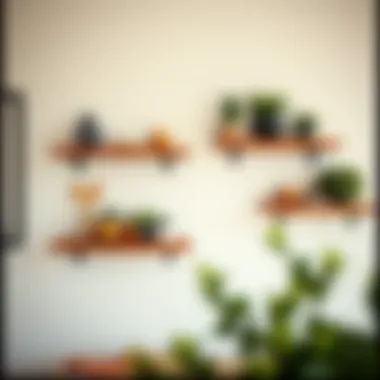

Consider a living room where height is available but floor area is constrained. By installing shelves above a couch, you not only free up precious table space but also create a stylish focal point. Another advantage here is that rustic shelves can be designed to fit into all sorts of odd nooks or corners, making the most of every inch. From rustic timber beams to vintage metal brackets, these elements can turn stark walls into gallery-like displays.
Versatility in Storage
Rustic shelves offer tremendous versatility, accommodating a wide array of items. They can store anything from books and decorative knickknacks to potted plants and kitchenware. This adaptability makes them suitable for various rooms, whether it’s a cozy kitchen or an expansive living area.
For instance, if you want to decorate a kitchen, you might consider using open shelving with rustic finishes to showcase beautiful ceramics while keeping essentials within easy reach. This approach caters to both functionality and aesthetics, making food preparation more enjoyable:
- Display beautiful dishware
- Store frequently used ingredients
- Organize spices in mason jars
In a study or reading nook, rustic shelves can hold books—but also provide space for art pieces, travel souvenirs, or even board games. This versatility invites creativity and personal expression, allowing homeowners to curate their own space.
Displaying Personal Collections
Displaying personal collections on rustic shelves can turn ordinary storage into an engaging narrative about who you are. Whether it's your extensive collection of vintage cameras, handcrafted pottery, or family heirlooms, rustic shelves offer the perfect canvas to showcase these treasures. The natural textures of wood create an inviting backdrop that enhances the beauty of these collections.
To bring this aspect to life, imagine a rustic shelf crafted from reclaimed wood hosting an assortment of unique items:
- Vintage postcards stacked in a decorative box
- A beautiful collection of glass bottles with different shapes or colors
- Family photographs framed in rustic style
Such displays not only serve as conversation starters but also add a distinctly personal touch to any room. It’s about transforming a simple shelf into a storyteller, weaving tales of travels, family history, and cherished memories. When guests walk in, they are greeted with glimpses of your life, inviting them to explore your interests and passions.
"Rustic shelves do more than hold items; they hold stories, characters, and moments in time."
With the above benefits, it’s clear that rustic shelves contribute significantly to both the aesthetics and functionality of a space. They maximize vertical space, offer versatile storage options, and provide a platform for personal expression. This makes them a frontrunner choice for homeowners and designers aiming to create thoughtful, inviting interiors.
Installation Methods for Rustic Shelves
When it comes to rustic shelves, the installation method can make or break the entire aesthetic. Choosing the right method not only impacts the overall design but also ensures functionality and durability. Various installation methods exist, each offering unique benefits and considerations that can affect the final look of your space, all while maximizing usability. In this section, we delve into the different ways to install rustic shelves, addressing everything from wall-mounted options to elaborate DIY projects.
Wall-Mounted Shelves
Wall-mounted rustic shelves are among the most common installation methods found in homes. They integrate seamlessly into living spaces, allowing users to take advantage of vertical wall spaces. One of the key advantages of wall-mounted shelves is their ability to create a focal point without consuming floor space. These shelves can support a variety of items, whether that’s books, plants, or decorative pieces, adding personalized character to your room.
When considering wall-mounted shelves, pay attention to the wall's carrying capacity, especially if you're displaying heavier items. Choosing the right brackets or anchors, and ensuring there's a solid stud to mount onto is crucial to avoid accidents. A well-installed wall-mounted shelf can provide both form and function, enhancing the rustic charm of a home.
Freestanding Options
Freestanding rustic shelves serve as excellent alternatives to wall-mounted units, providing flexibility in arrangement and easy relocation. These units can be placed anywhere without the need for permanent installation, making them ideal for renters or those who like to rearrange their homes frequently. Freestanding shelves can range from simple ladder-style constructions to heavy-duty bookcases.
One of the distinct benefits of freestanding shelves is their adaptability to various design themes and spaces. They can act as room dividers or simple displays, optimizing rooms while remaining aesthetically pleasing.
DIY Installation Techniques
The appeal of DIY installation for rustic shelves comes from the ability to personalize the look and functionality of your shelving solutions. With a pinch of creativity and a sprinkle of elbow grease, you can tailor your shelves to perfectly fit your space and style.
Tools Required
For any DIY installation, having the right tools is paramount. Essentials include a power drill, level, measuring tape, and appropriate anchors or brackets suited to the weight of your shelves. A circular saw can be great for cutting wood to size, while a screwdriver will come in handy for securing brackets. Many enthusiasts find that having these tools readily available not only expedites the project but also enhances the overall outcome.
These tools are beneficial because they allow for precision and safety when installing rustic shelves. The right equipment can make a challenging task more feasible, ultimately delivering a high-quality result that complements your design vision.
Step-by-Step Guide
Taking a methodical approach to installing rustic shelves is key in achieving a successful finish. First, you'll want to measure your space accurately, marking where to place the shelves. Follow that by assembling your materials and tools, setting up a clean workspace. Then, if you're using wall anchors or brackets, begin by drilling pilot holes before attaching them securely.
Once your brackets are in place, place your shelf and adjust with the level to ensure everything is even. This detailed, step-by-step approach makes the experience manageable and enjoyable; the satisfaction of seeing your shelves come to life provides a rewarding sense of achievement—and it’s a practical way to inject a unique touch into your space.
"DIY installation not only grants you freedom in design but also enriches your skills in home improvement. It’s about creating, customizing, and making your space truly yours."
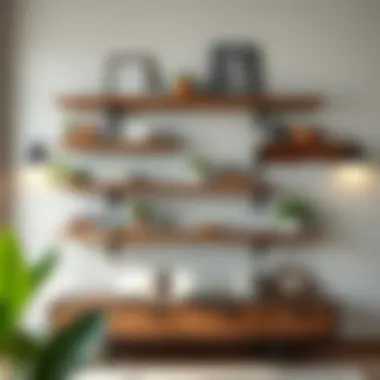

Integrating rustic shelves into your home becomes a fulfilling endeavor, enriching your living environment by balancing the charm of rustic aesthetics with unimposing functionality. Each installation method offers something distinct, allowing for an expansive range of creativity and design tailored to personal needs.
Integrating Rustic Shelves into Different Interior Styles
The integration of rustic shelves into various interior styles not only enriches the aesthetic of a space but also imbues it with a sense of character and warmth. Rustic shelving provides a practical yet artistic solution for homeowners and designers seeking to enhance their interiors. This approach is perfect for creating that unique fusion that a lot of modern homes crave, where utility meets decor in an effortless manner. Each style has different attributes that can be complemented by rustic elements. Knowing how to weave these shelves into diverse settings can make a world of difference in achieving a cohesive look.
Rustic Shelves in Contemporary Spaces
In contemporary design, clean lines and modern materials often dominate the aesthetic. However, introducing rustic shelves can introduce a tactile element that stark designs sometimes lack. Picture this: sleek white walls adorned with dark reclaimed wood shelves, providing not just storage, but creating a visual focal point. The juxtaposition highlights both the rustic charm of the wood and the sophistication of modern decor.
The trick is to keep the design balanced. For instance, in a contemporary kitchen, you can install open shelving made from weathered planks alongside minimalistic ceramics and glassware. This arrangement allows the rustic shelves to serve practical purposes while also contributing to the overall style by drawing the eye. The warmth of the wood contrasting against stainless steel appliances creates a welcoming atmosphere, inviting occupants and guests alike to feel at home.
Blending with Minimalism
Minimalism emphasizes simplicity, functionality, and a lack of clutter. Integrating rustic shelves into a minimalist space requires thoughtful consideration. The key is to choose shelves that do not overwhelm the visual appeal but enhance it subtly. For example, a simple plank made from salvaged wood can showcase only carefully selected items rather than a plethora of decor.
When you merge rustic elements with minimalism, you create a palette that feels organic and lived-in, yet streamlined. Consider a singular, floating shelf beneath a window, layered with a single potted plant and a small book. This combination can completely change the dynamic without making it feel out of place. You tell a story with fewer elements, turning each piece into a statement rather than mere decoration.
Achieving Eclectic Interiors
Eclectic style is all about contrast, variety, and the unexpected coming together. Rustic shelves shine brightly in such environments, offering a grounding element amid a mixture of patterns and textures. Using rustic wood shelves can tie together the various elements of an eclectic space by providing a unifying backdrop.
Imagine a room filled with vibrant art and colorful textiles. Introducing shelves made from rough-hewn timber provides a visual pause, helping to balance the riot of colors. You might arrange an array of artifacts from travels, books, and plants that can articulate the personality of the space. This not only highlights eclecticism but also allows for an ongoing narrative that evolves with the owner’s style over time.
Maintenance and Care for Rustic Shelves
Maintaining rustic shelves is not just about keeping them clean; it’s about preserving the character and integrity of the wood. These pieces often embody history and craftsmanship, thus deserving thoughtful care. Proper maintenance ensures that they not only look their best but also last longer, enhancing both functionality and aesthetic harmony in your space.
When rustic shelves are well-cared for, the natural beauty of the wood shines through and adds warmth to the surroundings. Rustic shelves are often made of materials that can weather over time, revealing unique textures and markings. Hence, knowing how to clean and protect them is essential.
Cleaning Techniques
Keeping rustic shelves clean is straightforward but requires some care to avoid damaging their finish. It’s wise to adopt a regimen that encompasses both surface cleaning and deeper care to remove grime that can build up over time.
- Dry Dusting: Use a soft, dry cloth or a microfiber duster to wipe away loose dust. This should be done regularly, perhaps once a week, to prevent debris from accumulating.
- Damp Cleaning: For deeper cleaning, slightly dampen a cloth with water or a mild wood cleaner and gently wipe the surfaces. Avoid soaking the wood; excess water can warp or degrade the material.
- Avoid Harsh Chemicals: Steer clear of abrasive cleaners and any product containing ammonia, as these can strip the finish off the wood.
- Spot Cleaning: For stains, dab the affected area with a cloth soaked in water. If necessary, a bit of white vinegar can help lift stubborn spots without harming the finish.
- Regular Inspection: Check for any signs of wear or damage frequently—tiny scratches or chips can sometimes benefit from touch-up paint or wood filler for a quick fix.
“A little routine care can prolong the life of your rustic shelves and keep them looking their finest.”
Protective Finishes
Protective finishes on rustic shelves serve as the first line of defense against moisture, spills, and dust accumulation. These finishes can enhance the natural beauty of the wood while providing essential protection, thus reinforcing the shelf’s longevity.
- Natural Oils: Oils such as tung oil or linseed oil penetrate deep into the wood, providing nourishment while preserving its natural appearance. They can also help to enhance the wood's grain and color.
- Polyurethane Coatings: For those looking for a more durable finish, polyurethane adds a protective, waterproof barrier, making it ideal for kitchen or bathroom environments. However, it can alter the natural look somewhat, so choose a satin finish for a more muted appearance.
- Wax Finishes: Wax can give rustic shelves a soft sheen and additional protection against scratches. While it requires reapplication over time, it’s an easy option that enhances the wood's character without altering its natural feel.
- Regular Reapplication: Depending on the finish, you can expect to reapply every few months or as needed. Pay attention to how the wood appears over time; if it starts to look dull, it might be time for a fresh coat.
With proper cleaning and protective measures, rustic shelves can remain attractive and functional for many years, adding a touch of natural beauty to your decor while serving practical purposes.
Finale
The exploration of rustic shelves extends beyond mere aesthetics; it touches on the very essence of home design. Rustic shelves serve as more than just storage; they are statements of style and practicality that can uplift the ambiance of any room. Integrating these shelves into home decor connects a person to nature, offering warmth and a sense of tranquility.
When selecting rustic shelving, consider the materials that resonate with your personal taste and the overall theme of your space. Choices like reclaimed wood stir feelings of history and sustainability, while industrial metals bring a sleek contrast to organic elements. Knowing the differences among wood types, such as the durability of hardwood versus the flexibility of softwood, is crucial in ensuring that your shelves are as functional as they are visually appealing.
Moreover, the installation methods and care of rustic shelves play into their long-term value as home assets. Proper placement for both wall-mounted and freestanding options is essential for maximizing space and functionality. Through following suggested maintenance tips, homeowners can ensure that their rustic shelves remain beautiful and useful for years to come.
In summary, rustic shelves embody a fusion of beauty and utility. By fully embracing the rustic aesthetic, you open up a world where design meets personal expression.
"Rustic shelves not only hold items; they hold stories and evoke memories that define our cherished spaces."
Final Thoughts on Rustic Shelves
As you reflect on the potential of rustic shelves, consider their versatility across various styles of home decor. These shelves allow homeowners and designers alike to marry practicality with artistry.
The charming imperfections found in natural wood grain or the raw finish of metal accents breathe character into rooms. If one wishes for a cottage ambiance or a more modern aesthetic, rustic shelves can seamlessly adapt as a central design element.
Beyond aesthetics, these shelves fulfill a fundamental need for storage solutions. They invite the organization of personal collections or everyday items in a fashion that feels both effortless and stylish. With the right care and design approach, rustic shelves become more than mere functional spaces—they evolve into focal points that tell a story and enhance the overall atmosphere of your home.


